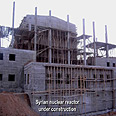A Syrian complex bombed by
Israel
bore features resembling those of an undeclared nuclear reactor and UN inspectors found "significant" traces of uranium at the site, a watchdog report said on Wednesday.
High-Level Links
Britain reestablished high-level intelligence links with Syrian authorities in bid to track movements of Islamic extremists into Iraq as Foreign Secretary David Miliband made his landmark visit to Damascus, Syrian officials tell The Times
But the International Atomic Energy Agency report said the findings gleaned from inspectors' visit to the site in June were not enough to conclude a reactor was once there. It said further investigation and greater Syrian transparency were needed.
The confidential nuclear safeguards report said Syria would be asked to show to inspectors debris and equipment whisked away from the site after the September 2007 Israeli air raid.
The United States gave intelligence to the IAEA last April that Washington said indicated the site was a reactor that was close to being built with North Korean assistance and designed to produce plutonium for atomic bombs.
Syria, an ally of Iran whose disputed uranium enrichment program has been under IAEA investigation for years, says the site destroyed was a disused military building and the uranium traces almost certainly came with the munitions used to bomb it.
Damascus has dismissed as fabricated the satellite imagery and other intelligence underpinning the investigation.
"While it cannot be excluded that the building in question was intended for non-nuclear use, the features of the building, along with the connectivity of the site to adequate pumping capacity of cooling water, are similar to what may be found in connection with a reactor site," said the IAEA report, sent to its 35-nation board of governors ahead of a November 27-28 meeting.
It noted Syria had not produced requested documentation to support its declarations about the nature of the building nor agreed to follow-up IAEA visits to three other locations seen as harboring possible evidence linked to Israel's target.
The IAEA intended to ask Syria to let inspectors take swipe samples from rubble and any equipment removed from the site.
It said IAEA Director Mohamed ElBaradei had urged Syria to "provide the necessary transparency including allowing visits to the requested locations and access to all available information for the agency to complete its assessment."
"Without such cooperation, we will not be able to make progress," said a senior UN official familiar with the report.
'Onus of this verification is on Syria'
The IAEA will ask Israel to answer Syria's remarks about the provenance of the uranium. Syria should also produce shrapnel from the bombing for testing purposes, he said.
UN officials said the uranium traces retrieved from soil samples at the site were a "chemically processed" form of the mineral that was not the enriched variety used to run nuclear power plants or in the core of atomic bombs.
But the element found was also not depleted uranium, the kind used to boost the penetrating power of munitions -- but primarily anti-tank shells, not aerial bombs, analysts say.
"There's enough uranium here to raise questions. The onus of this verification is on Syria," said a senior UN official. He said the uranium compound that turned up in environmental swipe samples was not in Syria's declared nuclear inventory.
Syria's only declared nuclear plant is an old research reactor. The IAEA has said Syria seems to lack the sophisticated technology and infrastructure needed to produce nuclear energy.
The report said Syria had told inspectors the site could not have been a nuclear facility because of unreliable, insufficient electricity supplies locally, limited available manpower and the lack of large quantities of treated water.
Another senior UN official said the investigation had urgent need of high-resolution pictures of the site he said must have been taken in the immediate aftermath of the bombing.
He said eight countries, which he declined to identify, had access to such imagery but had not turned it over to date.
The report complained that the investigation had been "severely hampered by (Israel's) unilateral use of force" and by a US failure to hand over relevant intelligence until seven months after the bombing -- after Syria swept the area clean and erected a new building on the spot.
"In light of (that), the agency's verification of the situation has been made more difficult and complex, as well as more time- and resource-consuming," the report said.

Alleged Syrian reactor
Photo: AFP
מומלצים















